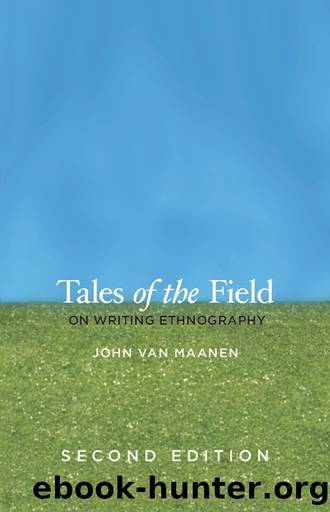Tales of the Field: On Writing Ethnography, Second Edition (Chicago Guides to Writing, Editing, and Publishing) by John Van Maanen

Author:John Van Maanen [Van Maanen, John]
Language: eng
Format: azw3
Publisher: University of Chicago Press
Published: 2011-05-31T16:00:00+00:00
5
Impressionist Tales
To recognize the poetic dimension of ethnography does not require one gives up facts and accurate accounting for the supposed freeplay of poetry. Poetry is not limited to romantic or modernist subjectivism; it can be historical, precise, objective.
James Clifford
The label I use for the tales considered in this chapter is drawn from art historians who regard impressionist painting as a novel representational form emerging in the West during the late nineteenth and early twentieth centuries.1 Impressionist painting sets out to capture a worldly scene in a special instant or moment of time. The work is figurative, although it conveys a highly personalized perspective. What a painter sees, given an apparent position in time and space, is what the viewer sees.
Renoir, Van Gogh, Seurat, and Monet are classic examples of impressionist painters. The movement itself took shape as artists moved away from idealized landscapes and formal portraits painted in the studio toward more familiar, common, everyday scenes done in situ. Roses and vases gave way to tangled wheat fields. An aristocrat and his horse gave way to a dreary night cafe. Impressionist painting is often marked by earthy group scenes of an unposed character (e.g., dance, tavern life, public gardens, family meals, street vendors, common vistas, plain rooms). The attempt is to evoke an open, participatory sense in the viewer and as with all revisionist forms of art, to startle complacent viewers accustomed to and comfortable with older forms. For my purposes, it is the impressionists’ self-conscious and, for their time, innovative use of their materials—color, form, light, stroke, hatching, overlay, frame—that provides the associative link to fieldwork writing.
The impressionists of ethnography are also out to startle their audience. But striking stories, not luminous paintings, are their stock-in-trade. Their materials are words, metaphors, phrasings, imagery, and most critically, the expansive recall of fieldwork experience. When these are put together and told in the first person as a tightly focused, vibrant, exact, but necessarily imaginative rendering of fieldwork, an impressionist tale of the field results.2 Such tales comprise a series of remembered events in the field in which the author was usually a participant. They are bundled together in such a way that they alter, in the end, whatever state or situation was said to obtain at the beginning of the tale. What makes the story worth telling is its presumably out of the ordinary or unique character. Impressionist tales are not about what usually happens but about what rarely happens. These are the tales that presumably mark and make memorable the fieldwork experience.3
Impressionist tales present the doing of fieldwork rather than simply the doer or the done. They reconstruct in dramatic form those periods the author regards as especially notable and hence reportable. Tales often initiate an analysis of the nature of cultural understanding and the fieldworker’s role as a student. Reflective, meditative themes may develop from the story and spin off in a number of fieldworker-determined directions. The story itself, the impressionist’s tale, is a representational means of cracking open the culture and the fieldworker’s way of knowing it so that both can be jointly examined.
Download
This site does not store any files on its server. We only index and link to content provided by other sites. Please contact the content providers to delete copyright contents if any and email us, we'll remove relevant links or contents immediately.
| Anthropology | Archaeology |
| Philosophy | Politics & Government |
| Social Sciences | Sociology |
| Women's Studies |
Cecilia; Or, Memoirs of an Heiress — Volume 1 by Fanny Burney(32075)
Cecilia; Or, Memoirs of an Heiress — Volume 3 by Fanny Burney(31469)
Cecilia; Or, Memoirs of an Heiress — Volume 2 by Fanny Burney(31419)
The Great Music City by Andrea Baker(30797)
We're Going to Need More Wine by Gabrielle Union(18641)
All the Missing Girls by Megan Miranda(14788)
Pimp by Iceberg Slim(13798)
Bombshells: Glamour Girls of a Lifetime by Sullivan Steve(13698)
Fifty Shades Freed by E L James(12925)
Talking to Strangers by Malcolm Gladwell(12889)
Norse Mythology by Gaiman Neil(12861)
For the Love of Europe by Rick Steves(11558)
Crazy Rich Asians by Kevin Kwan(8898)
Mindhunter: Inside the FBI's Elite Serial Crime Unit by John E. Douglas & Mark Olshaker(8722)
The Lost Art of Listening by Michael P. Nichols(7170)
Enlightenment Now: The Case for Reason, Science, Humanism, and Progress by Steven Pinker(6879)
The Four Agreements by Don Miguel Ruiz(6326)
Bad Blood by John Carreyrou(6285)
Weapons of Math Destruction by Cathy O'Neil(5848)
